The Nine Best-Run Countries in the World, What They Have in Common, and What They Have to Teach the U.S.
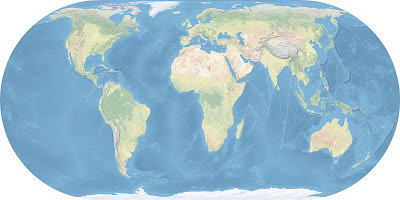 How to be among the best?
How to be among the best?For much of the twentieth century the United States could, quite factually, consider itself the most prosperous nation on earth. This, however, is no longer the case. While the US is not doing terribly, nine countries scattered over three continents are outperforming us along a wide variety of spectra. The nations in this “best-run” club all have higher levels of wealth, health and quality of life than the U.S. Though it’s hard to say definitively why they are healthy, wealthy and living so well, their public policy choices and infrastructure investments diverge significantly from ours. As we dig into their stats, we’ll see they share many traits in common.
Compared to the US, these nine countries are more egalitarian and less murderous. Per capita, they imprison far fewer people, and far fewer of their citizens die in road accidents. Their governments are less corrupt. Their cities are the greenest in the world and offer their residents advanced infrastructure, low crime rates, and high levels of security and stability. Each country as a whole saves more and has less debt per capita than the US. The populations of these countries own fewer cars than their US counterparts, and the ones they have they drive less. They take trains and transit, walk and bike at greater levels, and they spend less of their income on transportation as a household expense. These countries spend far less on their militaries and on health care than we do, but they spend far more at the pump for a gallon of gasoline. And all but one country achieve their high quality of life with less CO2 emissions per person than the US—many with less than half as much.
One might wonder if these countries are just as urban as ours? The answer is yes. Perhaps they are more homogenous and don’t have the challenges of assimilating immigrant populations? The answer is four have a higher percentage of immigrants than the US, one has comparable, and four have a lower percentage. Over half of these countries have vast, sparsely populated portions of countryside like we do. Four have rich mineral resources like the US does; five have almost none. Four are net energy exporters; five are net energy importers like the US. All but two have their own currency like the US does. All are democracies.
Who are these paragons of good national management? Norway, Switzerland, Australia, Sweden, Denmark, Finland, Netherlands, Austria and Canada. Let’s look closer at some of the surprising statistics that help us understand why and how these countries are doing so well.
Wealth
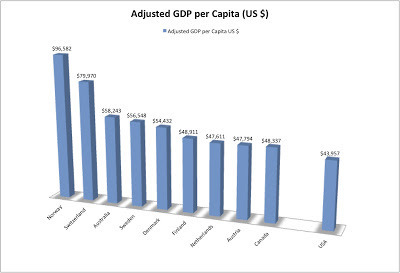 These nine countries are in the very top tier of GDP per capita in the world. All have greater GDP per person than the US. More importantly, all have higher GDP per capita after subtracting off their government deficit.
These nine countries are in the very top tier of GDP per capita in the world. All have greater GDP per person than the US. More importantly, all have higher GDP per capita after subtracting off their government deficit. 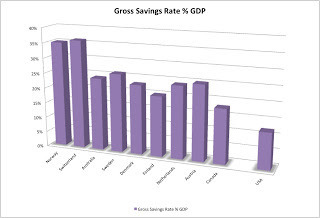 And all nine have high gross savings as a percent of GDP. As nations they consume smaller portions of what they earn. All except Austria and Finland ran trade surpluses in 2011. (In 2011, the US ran the greatest trade deficit in the world.)
And all nine have high gross savings as a percent of GDP. As nations they consume smaller portions of what they earn. All except Austria and Finland ran trade surpluses in 2011. (In 2011, the US ran the greatest trade deficit in the world.) 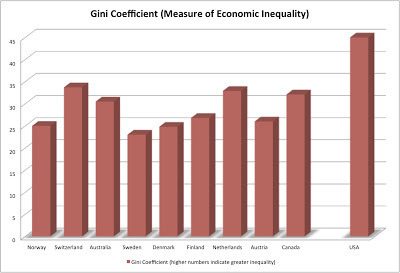 These countries are more egalitarian in wealth distribution. Their GINI coefficients (which measure how far from the center income is distributed) are all substantially lower than that of the U.S. This means there are fewer really poor people, fewer really rich people, and a lot more in the middle. (The US GINI is so high that our peers in inequality are Cameroon, Uruguay and Jamaica.)
These countries are more egalitarian in wealth distribution. Their GINI coefficients (which measure how far from the center income is distributed) are all substantially lower than that of the U.S. This means there are fewer really poor people, fewer really rich people, and a lot more in the middle. (The US GINI is so high that our peers in inequality are Cameroon, Uruguay and Jamaica.) These nine best-run countries also have more social mobility than the US as measured by how much one’s parents’ income predicts one’s own. The result is all nine countries are easier places to pull yourself up by your own bootstraps. And these nine countries aren’t over-regulated or hostile to business. Seven of the countries rank among the top 15 nations in the world for ease of doing business.
GovernmentThese nine countries have less government debt as a percent of GDP and they run substantially less annual deficits as a percent of GDP. Or, in the cases of Norway, Sweden and Switzerland, they run no deficits at all. In terms of national credit ratings tabulated by the World Economic Forum they rank 1, 2, 3, 4, 5, 8, 10, 12 and 13.(The US is number 11.) The same forum ranks these countries much higher than the US for protection of property, intellectual property protection, judicial independence, less favoritism in decisions of government officials, and less wasteful government spending.
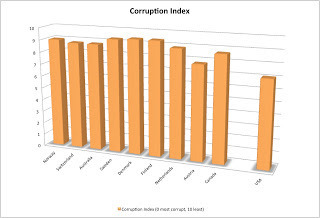 These nine countries also have more efficient legal frameworks for settling disputes, their government policy-making is more transparent, and, according to the Corruption Index, they are among the least corrupt governments in the world. The US, though certainly not the worst on the corruption measure, doesn’t even rank as first tier.
These nine countries also have more efficient legal frameworks for settling disputes, their government policy-making is more transparent, and, according to the Corruption Index, they are among the least corrupt governments in the world. The US, though certainly not the worst on the corruption measure, doesn’t even rank as first tier. In the Worldwide Governance Project rankings, these nine countries stood out as the most well-governed with the highest marks in the world (all higher than the US) for control of corruption, rule of law, regulatory quality, government effectiveness, political stability, absence of violence/terrorism, and voice and accountability (a measure of political participation, freedom of association, freedom of expression and a free media.)
 These nine countries all have a higher percentage of women elected to their main parliament or Congress, 25% - 45% versus the US rate of 18%. (More women = better governance? Just saying . . .) They also all have smaller parliamentary bodies (perhaps smaller = better functioning?) and each parliamentary member represents many fewer citizens (perhaps giving each individual citizen more influence and say in the political process?)
These nine countries all have a higher percentage of women elected to their main parliament or Congress, 25% - 45% versus the US rate of 18%. (More women = better governance? Just saying . . .) They also all have smaller parliamentary bodies (perhaps smaller = better functioning?) and each parliamentary member represents many fewer citizens (perhaps giving each individual citizen more influence and say in the political process?)In the World Economic Council’s assessment of infrastructure, seven of the nine countries ranked higher than the US. The rankings were: Switzerland (1), Finland (3), Austria (8), Netherlands (10), Denmark (13), Canada (15), Sweden (19), Australia (36) and Norway (39). The US came in number 25. All nine countries ranked higher than the US in quality of electrical supply.
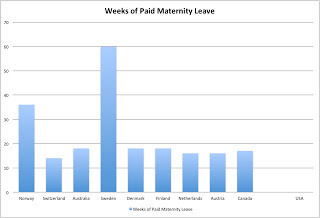 The nine best-run countries all offer more weeks of paid maternity leave. (The US offers none.) In eight of these countries workers routinely get 1-4 weeks more vacation, all mandated by government policy. (The US has no legal vacation minimums.)
The nine best-run countries all offer more weeks of paid maternity leave. (The US offers none.) In eight of these countries workers routinely get 1-4 weeks more vacation, all mandated by government policy. (The US has no legal vacation minimums.) 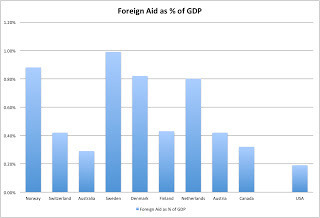
These nine countries all allocate substantially more of their annual GDP in aid to foreign countries.
MilitaryAs a percentage of their GDPs, these countries spend 1/5th to 2/5ths of what the US does. (The US spends more on its military than all other countries of the world combined.) None of these countries possess nuclear weapons. The nine countries ranked high (2, 4, 6, 9, 10, 14, 18, 22 and 28) out of 158 countries on the Global Peace Index. (The US ranked 88.) The index includes measures of internal and external stability, security and conflict.
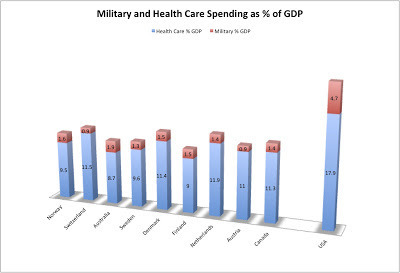 HealthThis is an area where the well-run nine run circles around the US. They spend oodles less on health care, both per capita and as a percent of GDP. And, to top it off, their results are better! First off, they have longer life expectancies. More importantly, they also have longer expected years of healthy life. (Which is the point of health care, right?)
HealthThis is an area where the well-run nine run circles around the US. They spend oodles less on health care, both per capita and as a percent of GDP. And, to top it off, their results are better! First off, they have longer life expectancies. More importantly, they also have longer expected years of healthy life. (Which is the point of health care, right?)
 They all have lower infant mortality rates. In addition, they have lower rates of obesity and diabetes, lower rates of heart disease. Most have lower rates of asthma and lung diseases of all kinds (7 countries out of 9) and alzheimers/dementia (8 out of 9). Their citizens are less likely to die from drug use, kidney disease, leukemia or birth trauma. The US cancer death rate is about average--four countries die from cancer at a lower rate than the US, five die at a higher rate. All nine countries have more practicing doctors per 1000 population than the US.
They all have lower infant mortality rates. In addition, they have lower rates of obesity and diabetes, lower rates of heart disease. Most have lower rates of asthma and lung diseases of all kinds (7 countries out of 9) and alzheimers/dementia (8 out of 9). Their citizens are less likely to die from drug use, kidney disease, leukemia or birth trauma. The US cancer death rate is about average--four countries die from cancer at a lower rate than the US, five die at a higher rate. All nine countries have more practicing doctors per 1000 population than the US. 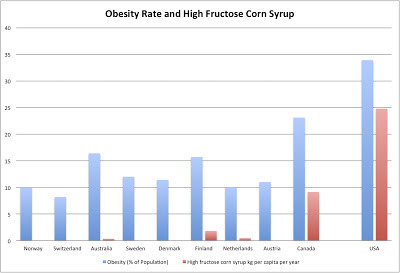 And then there’s lifestyle impacts on health costs. Smoking and drinking don’t seem to be responsible for inflating our health care costs. Six of these countries drink more alcohol per person than we do, seven of these countries smoke more than we do. But the citizens of these countries do consume far less high fructose corn syrup per person. The US consumes 55lbs of the stuff per person per year!
And then there’s lifestyle impacts on health costs. Smoking and drinking don’t seem to be responsible for inflating our health care costs. Six of these countries drink more alcohol per person than we do, seven of these countries smoke more than we do. But the citizens of these countries do consume far less high fructose corn syrup per person. The US consumes 55lbs of the stuff per person per year!In these countries people eat less meat, especially (except for Australia) beef. Their many fewer road accidents help keep health care costs down as well. (AAA estimates the costs of road accidents in the US to be $300 billion annually, or $955 per person.)
Other factors contributing to high US health care costs are that the US has the highest rate of CT scans, MRI exams, prescription drug use, prescription drug prices, and prescription drug spending. (Over 50% of Americans take at least one prescription drug each day. 25% of US adults take four or more different prescription drugs each day!) Not all of these nine countries have single payer health care but in none of these countries is healthcare tied in any way to employment.
Crime
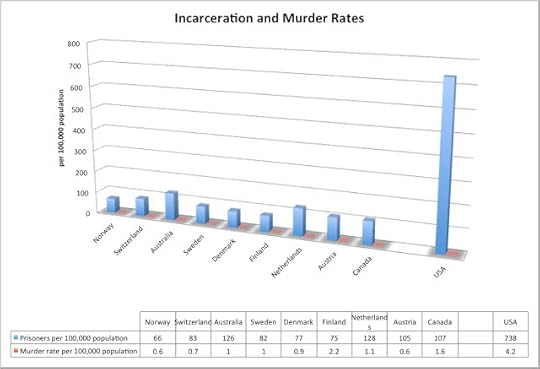 These nine countries imprison fewer people and have much lower murder rates. However, to be fair, the US is third in the world on the “Do you feel safe walking at night?” statistic. (Just behind Sweden and Canada, just ahead of Denmark, Finland and the Netherlands.) None of the nine have capital punishment.
These nine countries imprison fewer people and have much lower murder rates. However, to be fair, the US is third in the world on the “Do you feel safe walking at night?” statistic. (Just behind Sweden and Canada, just ahead of Denmark, Finland and the Netherlands.) None of the nine have capital punishment. According to the World Economic Forum, organized crime imposes much less toll on businesses in these countries. The US ranks 87 out of 144 countries on this measure, while our nine best-run countries rank 4, 12, 14, 19, 21, 22, 28, 30, and 44. On reliability of police services, they rank 1, 2, 6, 7, 8, 12, 13, 17, 18 while the US ranks 30th. On ethical behavior of firms they rank 2, 4, 5, 6, 7, 8, 9, 11, and 18 while the US ranks 29th. On auditing and reporting standards they rank 2, 6, 7, 8, 11, 12, 18, 23 and 33 while the US ranks 37th.
Transportation
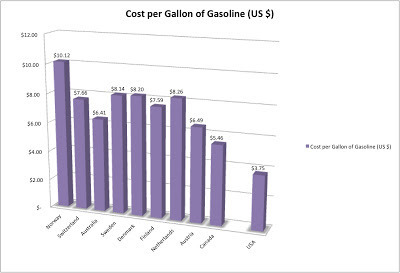 All but Canada have stricter blood alcohol levels legal for driving (US and Canada--.8, Finland, Austria, Switzerland, Netherlands, Australia--.5; Sweden and Norway--.2) All but Canada use less oil per person—five (Sweden, Denmark, Switzerland, Finland and Austria) consume approximately half the oil per person as the US. Gas pump price per gallon in these countries averages $7.59, more than twice the US price ($3.75.) (Note: highest gas price is in Norway, a net oil exporter.)
All but Canada have stricter blood alcohol levels legal for driving (US and Canada--.8, Finland, Austria, Switzerland, Netherlands, Australia--.5; Sweden and Norway--.2) All but Canada use less oil per person—five (Sweden, Denmark, Switzerland, Finland and Austria) consume approximately half the oil per person as the US. Gas pump price per gallon in these countries averages $7.59, more than twice the US price ($3.75.) (Note: highest gas price is in Norway, a net oil exporter.) 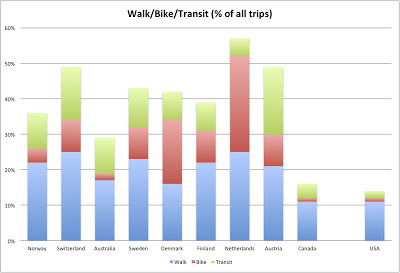 People in eight of these countries make nearly four times as many trips without the use of a car as people in the US. With the exception of Canada, they walk twice as much and bike ten times as much as in the US, especially for short trips. In the US, Americans drive 85% of trips 2/3 of a mile in length (a twelve minute walk) and even 55% of trips 1/3 of a mile in length (a six minute walk.) In seven of these countries the majority of children walk or bike to school. (In the US 85% of all children are driven to school in car or bus.)
People in eight of these countries make nearly four times as many trips without the use of a car as people in the US. With the exception of Canada, they walk twice as much and bike ten times as much as in the US, especially for short trips. In the US, Americans drive 85% of trips 2/3 of a mile in length (a twelve minute walk) and even 55% of trips 1/3 of a mile in length (a six minute walk.) In seven of these countries the majority of children walk or bike to school. (In the US 85% of all children are driven to school in car or bus.)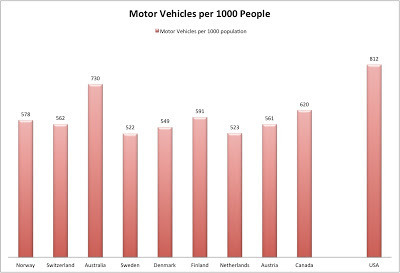 People in these nine countries have many fewer cars per capita. They travel many more miles by train.
People in these nine countries have many fewer cars per capita. They travel many more miles by train.
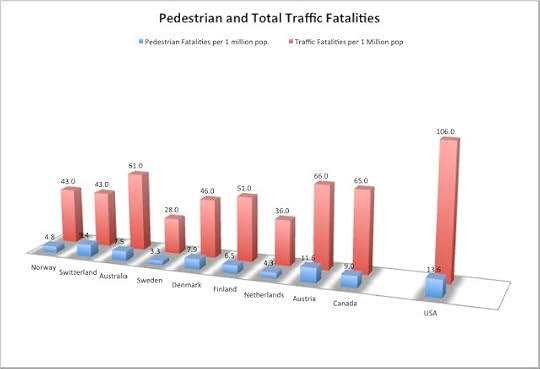 All nine nations have auto fatality rates that are a third to two-thirds of ours. Their pedestrian fatality rates per capita are, on average, half of ours, even though they do double the walking.
All nine nations have auto fatality rates that are a third to two-thirds of ours. Their pedestrian fatality rates per capita are, on average, half of ours, even though they do double the walking.CitiesThese nine countries have cities with the highest quality of living in the world as calculated by the Mercer Index (2012)—they fill 5 of the top ten spots, and 16 of the top 35 spots: Vienna, Austria (1), Zurich, Switzerland (2), Vancouver, Canada (5), Geneva, Switzerland (8), Copenhagen, Denmark (9), Bern, Switzerland (10), Sydney, Australia (11), Amsterdam, Netherlands (12), Ottawa, Canada (14), Toronto, Canada (15), Melbourne, Australia (17), Stockholm, Sweden (19), Perth, Australia. (21) Montreal, Canada (23), Helsinki, Finland (32), Oslo, Norway (32). The only US cities that rank in the top 35 are Honolulu (28) and San Francisco (29), and Boston (35).
These countries have the greenest cities in the world. The Siemens Green City Index rates cities based on their environmental performance and impact. Copenhagen had the highest rating in the world with (87.31) The other top city ratings were Stockholm (86.65), Oslo(83.98), Vienna (83.34), Amsterdam (83.03), Zurich (82.31,) Vancouver (81.30), Helsinki (79.29). US cities with the highest ratings were San Francisco (83.80), New York (79.20), Seattle (79.10) (Australian cities were not evaluated.)
Energy
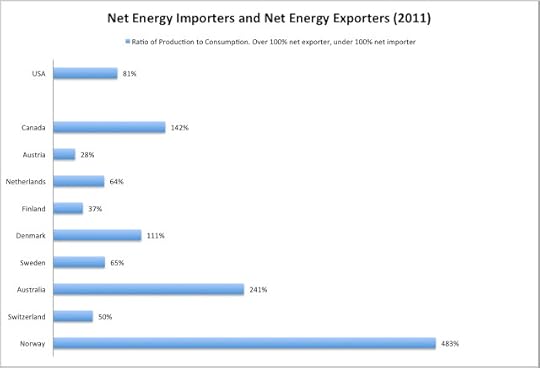 Energy is a complex topic. Consumption and production patterns are influenced by each country’s mineral and hydroelectric resources as well as by their investment in various forms of energy-producing infrastructure. In the coming decades energy use will have an enormous impact on every country’s prosperity. Four of the nine countries (Norway, Denmark, Canada and Australia) are net energy exporters. Five are net energy importers like the US. Two of them (Austria and Finland) import close to two-thirds of the energy they consume.
Energy is a complex topic. Consumption and production patterns are influenced by each country’s mineral and hydroelectric resources as well as by their investment in various forms of energy-producing infrastructure. In the coming decades energy use will have an enormous impact on every country’s prosperity. Four of the nine countries (Norway, Denmark, Canada and Australia) are net energy exporters. Five are net energy importers like the US. Two of them (Austria and Finland) import close to two-thirds of the energy they consume. 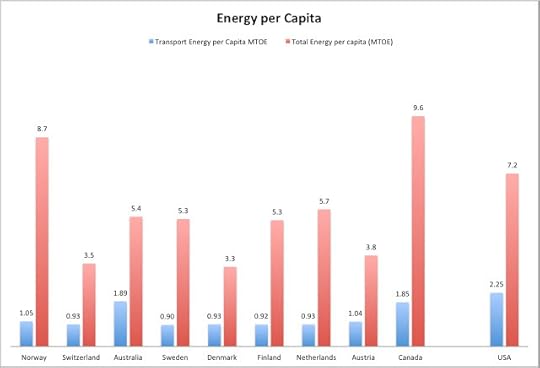 All the countries but Norway and Canada use less total energy per person than the US (some half as much) and all use less energy for transportation. Except for Australia, they all emit less CO2 per person (some half as much).
All the countries but Norway and Canada use less total energy per person than the US (some half as much) and all use less energy for transportation. Except for Australia, they all emit less CO2 per person (some half as much). 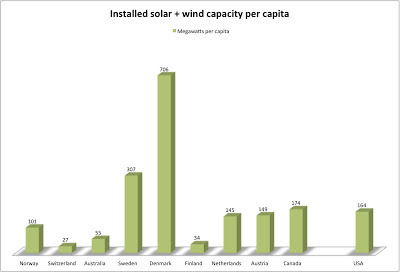 Sweden, Denmark and Canada in particular have made greater investments in installed solar and wind capacity per capita than the US, and the Netherlands and Austria are catching up.
Sweden, Denmark and Canada in particular have made greater investments in installed solar and wind capacity per capita than the US, and the Netherlands and Austria are catching up.
 In general the more coal consumed, the greater the CO2 emissions. Oil consumption also has a large impact on CO2 emissions; natural gas has less. Not surprisingly the nations that are extremely energy efficient with extensive transit and train systems tend to have the lowest CO2 emissions. (Note: TOE stands for Tons of Oil Equivalent, a way to compare different sources of energy.)
In general the more coal consumed, the greater the CO2 emissions. Oil consumption also has a large impact on CO2 emissions; natural gas has less. Not surprisingly the nations that are extremely energy efficient with extensive transit and train systems tend to have the lowest CO2 emissions. (Note: TOE stands for Tons of Oil Equivalent, a way to compare different sources of energy.)HappinessSo what in the end is a point of a government, the point of a country, if not the happiness and life satisfaction of its citizens? In the World Happiness Report produced by the Earth Institute of Columbia University, happiness and life satisfaction levels are assessed through a number of different evaluation measures. Living standards and income undoubtedly contribute to happiness but so do a person’s health (physical and mental), education, values held (such as the level of materialism or altruism), job security, meaningful work, social connections and social engagement. Or, on a more macro level, good governance, freedom (ability of citizens to choose the course of their own lives,) levels of trust in society, and levels of social mobility. (Spiritual connection/spiritual meaning and/or connection with the natural world also come into play.) On happiness/life satisfaction scales we see Denmark (1), Finland (2), Norway (3), Netherlands (4), Canada (5), Switzerland (6), Sweden (7), Australia (9), and Austria (13) out of 150 countries, with the US coming in at (11).
What Does All This Tell Us? Now correlation is not causation. And there are so many factors at work here it’s hard to pin down what might be cause and what might be effect. But it's pretty clear that low corruption is a prerequisite for good governance. It’s pretty clear that low CO2 emissions require reduced burning of fossil fuels. It’s pretty clear that electricity via sources other than coal and transportation via methods other than private auto result in less burning of fossil fuels. It’s pretty clear if a nation puts a disproportionate portion of its wealth towards its military and poorly-run health care system, it will have little money to put towards infrastructure such as transit, trains or renewable energy.
If we could achieve the energy efficiency of Denmark, the transportation efficiency of Sweden, the walking and biking rates of the Netherlands, the lack of government corruption of Finland, the oil consumption and transit use rates of Austria, the rail travel rates of Switzerland, the low healthcare costs and high healthy life expectancy of Australia, the low coal use of Norway, and Canada’s level of military expenditure, the US would be in extremely good shape. We could stop burning coal, end fracking, end foreign oil imports and be entirely energy self-sufficient. Our health care and energy costs would drop dramatically, as would our trade deficit. With reduced expenditure on the military, it’s even possible our national deficit would disappear. Our population would be happier, healthier, live longer, and enjoy a higher quality of life.
To go further, if the US wants to be among the most prosperous nations on earth, we need to encourage active forms of transportation for short trips, develop transit and rail systems for longer trips, reduce income inequality and corruption, become highly energy-efficient, reduce military expenditures to 1.5% of GDP, and reduce health care expenditures to 11% of GDP. This appears to me to be the lesson of our nine best-run countries.
Sources of data: OECD library, UN Data, BP Statistical Review of World Energy 2012, IEA Statistics 2012, EIA, CIA World Factbook, IRTAD Road Safety Annual Report 2011, Mercer Quality of Living Rankings 2012, World Happiness Report, Journal of Physical Activity and Health, Bicycling and Walking in the United States 2012 Benchmarking Report, EU Transport in Figures Statistical Pocketbook 2012, EU EDGAR data, World Economic Forum, International Transport Forum, Human Development Report 2007/2008, Global Competivenss Report 2012/2013, Renewables 2012 Global Status Report, Global Peace Index, Trends in Global CO2 emissions 2012 Report, Corruption Perception Index, The Economist, Siemens Green City Index.
Published on December 18, 2012 22:28
No comments have been added yet.



